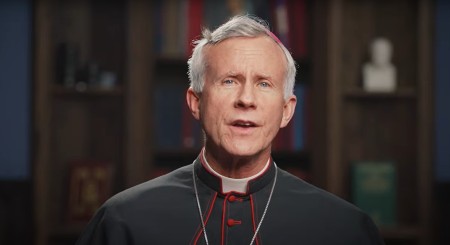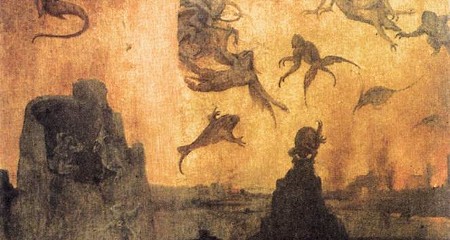We ask you, urgently: don’t scroll past this
Dear readers, Catholic Online was de-platformed by Shopify for our pro-life beliefs. They shut down our Catholic Online, Catholic Online School, Prayer Candles, and Catholic Online Learning Resources—essential faith tools serving over 1.4 million students and millions of families worldwide. Our founders, now in their 70's, just gave their entire life savings to protect this mission. But fewer than 2% of readers donate. If everyone gave just $5, the cost of a coffee, we could rebuild stronger and keep Catholic education free for all. Stand with us in faith. Thank you.Help Now >
Medjugorje at 25: Pilgrims still flock
FREE Catholic Classes
ROME - Twenty-five years after six children in Medjugorje, a village in what is now Bosnia-Herzegovina, began reporting apparitions of Mary, pilgrims are still flocking to the site and church officials are still cautious about the authenticity of the events.
Highlights
Catholic News Service (www.catholicnews.com)
6/19/2006 (1 decade ago)
Published in Living Faith
Marian experts continue to debate the significance of Medjugorje, and several have published books - ranging from enthusiastically supportive to skeptical - to coincide with the anniversary. In Medjugorje, Franciscan pastors are preparing for overflow crowds on June 24-25, the dates on which the alleged apparitions and messages began in 1981. They insist, however, that no special commemorations are planned. "Everything's been booked solid for more than a year, and we're expecting thousands of pilgrims. But we're not putting on any spectacle or festival - just the usual program of prayer," Franciscan Father Ivan Sesar, pastor of St. James Parish in Medjugorje, said in a telephone interview. Of the six children who originally reported visions from Mary, sometimes daily, one says she still receives messages from Mary on the 25th of each month. They are published online, eagerly awaited by a large network of Christians dedicated to Medjugorje. According to Bishop Ratko Peric of Mostar-Duvno, whose diocese includes Medjugorje, the messages now number more than 30,000, a fact that only increases his own skepticism about the authenticity of the apparitions. Bishop Peric discussed Medjugorje with Pope Benedict XVI earlier this year during a visit to the Vatican. In a summary of the discussion published in his diocesan newspaper, Bishop Peric said he had reviewed the history of the apparitions with the pope, who already was aware of the main facts from his time as head of the Congregation for the Doctrine of the Faith. "The holy father told me: We at the congregation always asked ourselves how can any believer accept as authentic apparitions that occur every day and for so many years?" Bishop Peric said. Bishop Peric noted that Yugoslavian bishops in 1991 issued a statement that "it cannot be confirmed that supernatural apparitions or revelations are occurring" at Medjugorje. Bishop Peric said he told the pope that his own opinion was even stronger - not only that a supernatural element cannot be proven, but that "it is certain that these events do not concern supernatural apparitions." Other priests and bishops have spoken favorably about the apparitions, saying there is no reason to doubt the sincerity of the visionaries or the spiritual effects among pilgrims. At Medjugorje, the debate over authenticity has been largely set aside by the Franciscan friars who minister to pilgrims and keep in contact with the visionaries. "We are not here to give a judgment about whether the apparitions are true or not. We're here to follow the people who come, to hear their confessions, to give them pastoral care," said Father Sesar, the 39-year-old pastor. Father Sesar said that, while early pilgrims to Medjugorje may have been drawn there by curiosity or a thirst for supernatural signs like rosaries turning different colors, that is less true today. Much more significant are the long lines for confession that form every day, he said. "The biggest things in Medjugorje today are prayer and the sacraments. It's no longer a place where people come to see miracles. They are coming for spiritual growth," he said. Considerable attention, however, is still given to the apparitions and messages which one of the visionaries, Marija Pavlovic-Lunetti, says she continues to receive. She now lives with her husband and children in Italy. The message from May 2006 strikes a pious tone typical of most of the thousands of alleged communications over the last 25 years: "Decide for holiness, little children, and think of heaven. Only in this way will you have peace in your heart that no one will be able to destroy. Peace is a gift, which God gives you in prayer." At the Vatican, officials said they are still monitoring events at Medjugorje, but emphasized that it was not necessarily the Vatican's role to issue an official judgment on the alleged apparitions there. More than once in recent years, the Vatican has said that dioceses or parishes should not organize official pilgrimages to Medjugorje. That reflects the policy of the bishops. But the Vatican has also said Catholics are free to travel to the site, and that if they do the church should provide them with pastoral services. That has left a margin of ambiguity among Catholics. Adding to the confusion have been claims that the late Pope John Paul II strongly supported Medjugorje in various private statements; the Vatican has never confirmed those statements. After Pope Benedict was elected, it was rumored that as a cardinal he had once traveled incognito to Medjugorje, and that as pope he could be expected to officially approve the site as a Marian shrine. In his February visit to the Vatican, Bishop Peric said he spoke to the pope about these rumors, and that the pontiff only laughed in surprise. Pope Benedict, who headed the doctrinal congregation for 24 years, once said the multiplication of Marian apparitions was a "sign of the times" and should not be discounted. But he has also counseled prudence, even when it comes to apparitions officially recognized by the church, like those at Fatima, Portugal; Guadalupe, Mexico; and Lourdes, France. Behind the Vatican's careful approach is a basic church teaching: that public revelation ended with the death of the last apostle, and that no private revelation, however interesting, will add anything essential to the faith. Yet some, like Msgr. Arthur Calkins, a Vatican official and a member of the Pontifical International Marian Academy, believe that while apparitions do not furnish new truths of faith, they can help Catholics understand them better. Private revelations recognized by the authority of the church "may serve to bring home to the faithful truths which are already known, but not fully appreciated," Msgr. Calkins said in an interview. "The apparitions of Our Lady at Fatima, for example, brought home to the faithful the need for prayer, penance, conversion of heart, reparation for sins. All of this expands on the doctrine of the mystical body of Christ," he said. Like several other experts at the Vatican, Msgr. Calkins declined to offer any opinion about Medjugorje. Marian expert Donal Foley, in his new book, Understanding Medjugorje, reviews the public evidence, particularly from the early days of the reported visions, and says that, "sadly, the only rational conclusion about Medjugorje is that it has turned out to be a vast, if captivating, religious illusion." In a phone interview, Foley listed several factors that make him dubious: contradictions over how long the apparitions would continue, the excess number of messages, their questionable and sometimes "silly" content, excess focus on inexplicable "signs," and the credulous local culture in Medjugorje. Foley said it was obvious that some Medjugorje pilgrims have experienced spiritual awakening. But he said part of this could be attributed to a "charismatic element that grabs people's emotions." Another factor, he said, is that Medjugorje may appeal to Catholics confused by changes after the Second Vatican Council. "It's a sad reality that some people have had to go to Medjugorje to get priests who were enthusiastic about confession, and to get the things they used to be able to get in the church in the West," he said. Other writers have used the 25th anniversary as an occasion to celebrate Medjugorje. Elizabeth Ficocelli's The Fruits of Medjugorje offers more than 200 pages of what she says are "stories of true and lasting conversion." In a special anniversary edition of Medjugorje, The Message, Wayne Weible says that more than 30 million people have made the trip to Medjugorje, where what is "arguably the greatest apparition in recorded Marian history" is still going on.
---
Copyright (c) 2007 Catholic News Service/U.S. Conference of Catholic Bishops
Join the Movement
When you sign up below, you don't just join an email list - you're joining an entire movement for Free world class Catholic education.
-

-
Mysteries of the Rosary
-
St. Faustina Kowalska
-
Litany of the Blessed Virgin Mary
-
Saint of the Day for Wednesday, Oct 4th, 2023
-
Popular Saints
-
St. Francis of Assisi
-
Bible
-
Female / Women Saints
-
7 Morning Prayers you need to get your day started with God
-
Litany of the Blessed Virgin Mary
5 Biblical Warnings We All Must Heed
-

WHAT WILL IT TAKE? | Bishop Strickland Calls Out Silent Bishops in Strong Public Letter
-

Giants of the Fallen: Unveiling the Mystery of the Nephilim from a Catholic Perspective
-
Ancient Wisdom, Modern Choices: How Ecclesiastes 10:2 Illuminates Today's Political Divide
-
How Do We Know Truth? A Catholic Perspective
Daily Catholic
 Daily Readings for Monday, November 18, 2024
Daily Readings for Monday, November 18, 2024 St. Rose Philippine Duchesne: Saint of the Day for Monday, November 18, 2024
St. Rose Philippine Duchesne: Saint of the Day for Monday, November 18, 2024 Bless Me, Heavenly Father.: Prayer of the Day for Monday, November 18, 2024
Bless Me, Heavenly Father.: Prayer of the Day for Monday, November 18, 2024- Daily Readings for Sunday, November 17, 2024
- St. Elizabeth of Hungary: Saint of the Day for Sunday, November 17, 2024
- Prayer to Saint Anthony of Padua, Performer of Miracles: Prayer of the Day for Sunday, November 17, 2024
![]()
Copyright 2024 Catholic Online. All materials contained on this site, whether written, audible or visual are the exclusive property of Catholic Online and are protected under U.S. and International copyright laws, © Copyright 2024 Catholic Online. Any unauthorized use, without prior written consent of Catholic Online is strictly forbidden and prohibited.
Catholic Online is a Project of Your Catholic Voice Foundation, a Not-for-Profit Corporation. Your Catholic Voice Foundation has been granted a recognition of tax exemption under Section 501(c)(3) of the Internal Revenue Code. Federal Tax Identification Number: 81-0596847. Your gift is tax-deductible as allowed by law.






 Daily Readings for Monday, November 18, 2024
Daily Readings for Monday, November 18, 2024 St. Rose Philippine Duchesne: Saint of the Day for Monday, November 18, 2024
St. Rose Philippine Duchesne: Saint of the Day for Monday, November 18, 2024 Bless Me, Heavenly Father.: Prayer of the Day for Monday, November 18, 2024
Bless Me, Heavenly Father.: Prayer of the Day for Monday, November 18, 2024

